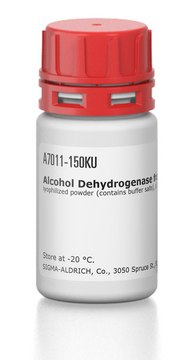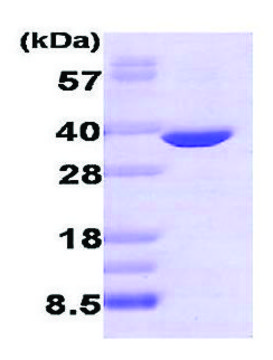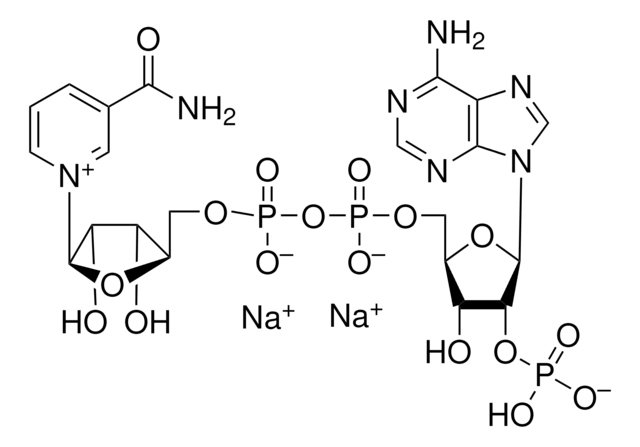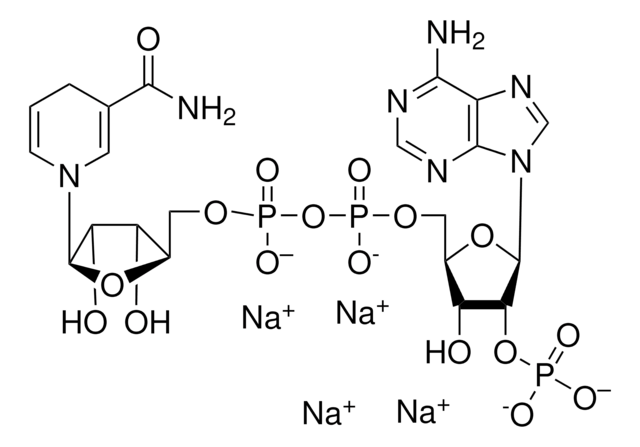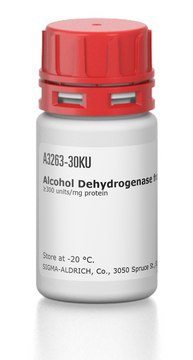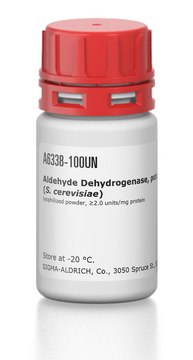77857
Ketoreductase
recombinant, expressed in E. coli, ≥0.2 U/mg
Sign Into View Organizational & Contract Pricing
All Photos(1)
Recommended Products
recombinant
expressed in E. coli
form
powder
specific activity
≥0.2 U/mg
storage temp.
2-8°C
Looking for similar products? Visit Product Comparison Guide
Application
Ketoreductases are used to study the stereospecificity of ketoreductase domains . They may be used to reduce precursors of α-chloroalcohols, which are synthetic intermediates for various pharmaceutical compounds .
Biochem/physiol Actions
Ketoreductase, Product 77857, reduces 4-chloroacetoacetate with NADPH as a cosubstrate.
Packaging
Bottomless glass bottle. Contents are inside inserted fused cone.
Unit Definition
1 U corresponds to the amount of enzyme which reduces 1 μmol 4-chloroacetoacetate per minute at pH 6.0 and 25°C (cosubstrate NADPH).
Signal Word
Danger
Hazard Statements
Precautionary Statements
Hazard Classifications
Resp. Sens. 1 - Skin Sens. 1
WGK
WGK 3
Flash Point(F)
Not applicable
Flash Point(C)
Not applicable
Regulatory Information
常规特殊物品
Certificates of Analysis (COA)
Search for Certificates of Analysis (COA) by entering the products Lot/Batch Number. Lot and Batch Numbers can be found on a product’s label following the words ‘Lot’ or ‘Batch’.
Already Own This Product?
Find documentation for the products that you have recently purchased in the Document Library.
Automation Highlights from the Literature
Kerstin Thurow and Hilmar Weinmann
Journal of Laboratory Automation, 11, 1-6 (2006)
Roselyne Castonguay et al.
Journal of the American Chemical Society, 130(35), 11598-11599 (2008-08-13)
Tylactone synthase (TYLS) is a modular polyketide synthase that catalyzes the formation of tylactone (1), the parent aglycone precursor of the macrolide antibiotic tylosin. TYLS modules 1 and 2 are responsible for the generation of antidiketide and triketide intermediates, respectively
Carol Larroy et al.
European journal of biochemistry, 269(22), 5738-5745 (2002-11-09)
A new NADP(H)-dependent alcohol dehydrogenase (the YCR105W gene product, ADHVII) has been identified in Saccharomyces cerevisiae. The enzyme has been purified to homogeneity and found to be a homodimer of 40 kDa subunits and a pI of 6.2-6.4. ADHVII shows
Guangming Xiong et al.
Chemico-biological interactions, 178(1-3), 215-220 (2008-11-13)
3Alpha-hydroxysteroid dehydrogenase/carbonyl reductase from Comamonas testosteroni is a key enzyme in the degradation of steroids in the environment. The encoding gene, hsdA, is expressed only at very low levels in the absence of steroids, but undergoes a several fold induction
X Li et al.
Wei sheng wu xue bao = Acta microbiologica Sinica, 41(4), 463-468 (2003-01-30)
ANADPH-dependent 2-Oxoaldehyde reductase was isolated and purified from a marine bacteria Bacillus sp. The purification procedure involved ammonium sulfate fractionation and Q Sepharose FF, Hydroxyapatite, Sephadex G-100 column chromatographies. The specific activity of the purified enzyme was increased by 141.1
Our team of scientists has experience in all areas of research including Life Science, Material Science, Chemical Synthesis, Chromatography, Analytical and many others.
Contact Technical Service